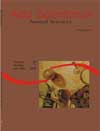<b>Produção e contaminação por helmintos parasitos de ovinos, em forrageiras de diferentes hábitos de crescimento</b> - DOI: 10.4025/actascianimsci.v26i3.1824
Resumo
O experimento foi realizado no Centro de Pesquisa do Arenito, Cidade Gaúcha, Paraná, pertencente à Universidade Estadual de Maringá, Estado do Paraná, nos períodos de verão e inverno. Foram utilizadas 60 ovelhas ½ Bergamácia ½ Corriedale, distribuídas em delineamento inteiramente casualizado em três piquetes de um hectare cada, formados por gramíneas de diferentes hábitos de crescimento: Pensacola (Paspalum notatum), Coast cross (Cynodon dactylon) e Tanzânia (Panicum maximum cv. Tanzânia). O objetivo foi determinar o comportamento de larvas infectantes de endoparasitos de ovinos, no terço superior de gramíneas, ao longo do dia, bem como a disponibilidade de matéria seca das mesmas. Não houve diferença quanto ao comportamento das larvas nas pastagens entre os períodos de verão e inverno e entre as espécies forrageiras. Entretanto, obteve-se resposta linear decrescente do número de larvas no terço superior das plantas em função do período de insolação. Provavelmente houve migração das larvas para as partes mais baixas das plantas ao longo do dia, orientando, assim, a entrada dos ovinos nos piquetes nos horários de maior incidência solar. Não houve diferença na disponibilidade de matéria seca entre os períodos, porém, o Pensacola apresentou menor disponibilidade no inverno (1551 vs 1259kg MS/ha). Todas as forrageiras apresentaram menor teor de proteína bruta no inverno.Downloads
DECLARAÇÃO DE ORIGINALIDADE E DIREITOS AUTORAIS
Declaro que o presente artigo é original, não tendo sido submetido à publicação em qualquer outro periódico nacional ou internacional, quer seja em parte ou em sua totalidade.
Os direitos autorais pertencem exclusivamente aos autores. Os direitos de licenciamento utilizados pelo periódico é a licença Creative Commons Attribution 4.0 (CC BY 4.0): são permitidos o compartilhamento (cópia e distribuição do material em qualqer meio ou formato) e adaptação (remix, transformação e criação de material a partir do conteúdo assim licenciado para quaisquer fins, inclusive comerciais.
Recomenda-se a leitura desse link para maiores informações sobre o tema: fornecimento de créditos e referências de forma correta, entre outros detalhes cruciais para uso adequado do material licenciado.








































